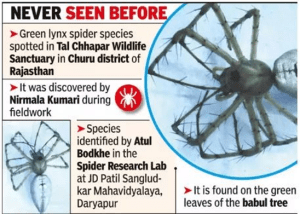TAG: GS 3: ECOLOGY AND ENVIRONMENT
THE CONTEXT: Daryapur-based arachnologist has identified the green lynx spider, which was never discovered earlier.
EXPLANATION:
Peucetia chhaparajnirvin:
- Peucetia chhaparajnirvin is a newly identified species of green lynx spider found in the Tal Chhapar Wildlife Sanctuary in the Churu district of Rajasthan, India.
- This spider species was discovered by Daryapur-based arachnologist and named after the area where it was found, Tal Chhapar.
- Peucetia chhaparajnirvin is known for its green hue that helps it blend with its surroundings, its long legs for swift movement.
- As typical of lynx spiders, this species preys on small insects. It captures its prey through pouncing rather than constructing webs, making it an active predator in its habitat.
- Peucetia chhaparajnirvin is primarily active during the night, exhibiting nocturnal behavior patterns.
- These spiders possess a green hue that aids in camouflage, blending seamlessly with their leafy surroundings.
- It belongs to the family Oxyopidae within the order Araneida and is characterized by its hexagonally arranged eyes and pointed abdomen.
- Lynx spiders are characterized by their hexagonally arranged eyes and pointed abdomens.
- Many species within this family exhibit colorful striped abdomens and spiky legs, adding to their distinct appearance.

Tal Chhapar Wildlife Sanctuary:
- Tal Chhapar Wildlife Santuary is located in Sujangarh tehsil of Rajasthan’s Churu district and spanning 7.1977 square Km.
- It is situated on the border of the Great Indian Thar Desert.
- It was established as a “Reserved area” in 1962 and was given the status of a sanctuary in 1966.
- This Sanctuary has nearly flat territory and combined thin low lying region.
- The sanctuary is home to over 4,500 Blackbucks, Chinkara, and more than 250 species of birds, including migratory raptors.
- It has got open and wide grasslands with spread Acacia and Prosopis plants that offer it a look of a characteristic Savanna.

